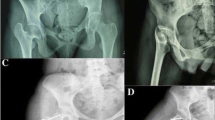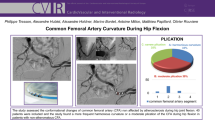Summary
The behavior of the femoral a. when the hip joint passes from the position of extension to the Position of flexion at 90° was studied in 13 cadavers, using several methods: anatomic sections, arteriographies or vascular casts. The modifications of the direction and shape of the femoral a. were assessed in the frontal and sagittal planes. They result from a movement combining flexion and torsion of the femoral a. on its axis at 2 different points in its course. The change of direction of the artery in the sagittal plane is the most obvious modification. It corresponds to the displacement and to the inversion of an angle of 45° on the course of the artery. This angle is situated below the level of the inguinal ligament when the hip joint is in extension and above the sartorius m. when it is flexed to 90°. If these modifications are produced in a similar manner in the living subject, they would seem to correspond to the best possible functional adaptation of the femoral a. They may be involved in the genesis of prosthetic aneurysms.
Résumé
Le comportement de l'a. fémorale quand l'articulation de la hanche passe de la position d'extension à la position de flexion à 90° a été étudié sur 13 cadavres. Plusieurs méthodes, coupes anatomiques, artériographies ou moulages vasculaires, ont été utilisées. Les modifications de la direction et de la forme de l'a. fémorale ont été évaluées dans le plan frontal et dans le plan sagittal. Elles résultent d'un mouvement associant la flexion et la torsion sur son axe de l'a. fémorale en 2 points différents de son trajet. Le changement de direction de l'a. fémorale dans le plan sagittal est la modification la plus évidente. Il correspond au déplacement et à l'inversion d'un angle de 45° sur le trajet de l'artère. Cet angle est situé au-dessous du niveau du ligament inguinal quand l'articulation de la hanche est en extension et au-dessus du m. sartorius quand elle est fléchie à 90°. Si elles se produisent de manière semblable chez le sujet vivant, ces modifications semblent correspondre à la meilleure adaptation fonctionnelle possible de l'a. fémorale. Elles pourraient intervenir dans la genèse des anévrysmes prothétiques.
Similar content being viewed by others
References
Courbier R, Larranaga J, Ferdani M, Jausseran J-M, Reggi M, Bergeron P (1982) Les faux anévrysmes sur prothèse artérielle. Chirurgie 108: 459–464.
Ferdani M, Delpero J-R, Courbier R (1985) A gliding' space between the femoral artery and inguinal ligament. Mecanism of formation of false aneurysm. Anat Clin 7: 131–135
Hayek H Von (1935) Das Verhalten der Arterien bei Beugung der Gelenke. Z Anat Entwickl Gesch 105: 25–36
Mosimann R, Walder J, Van Melle G (1985) Stenotic intimal thickening of the external iliac artery: illness of the competition cyclists ? Report of two cases. Vasc Surg 19: 258–263
Paturet G (1951) Traité d'anatomie humaine. Masson, Paris, Tome II, pp. 933–957
Pissas A, Bouchet Y, Bodin J-P, Peralta J-L (1979) La lame cellulo-adipeuse du canal fémoral. Bull Assoc Anat 63: 243–247
Rideau Y, Videau J, Bonjean P, Kamina P (1966) Etudes radio-anatomiques sur le niveau d'origine de l'artère fémorale profonde. Bull Assoc Anat 133: 768–774
Rouvière H (1974) Anatomie humaine. Masson Paris, 11e édition, tome III, pp 399–405 et pp 455–462
Szilagyi D-E, Whitcomb JG, Schenker W, Waibel P (1960) The laws of fluid flow and arterial grafting. Surgery 47: 55–73
Vernon P (1985) Etude anatomo-radiologique des modifications de l'axe ilio-fémoro-poplité au cours des flexions articulaires du membre pelvien. Thèse Med Reims
Vernon P, Delattre J-F, Johnson E-J, Palot J-P, Clément C (1987) Dynamic modifications of the popliteal arterial axis in the sagittal plane during flexion of the knee. Surg Radiol Anat 9: 37–41
Videau J (1968) Notes sur le tronc artériel ilio-fémoral chez l'homme. Bull Assoc Anat 139: 1200–1208
Author information
Authors and Affiliations
Rights and permissions
About this article
Cite this article
Lopez, J.F., Magne, J.L. & Champetier, J. The femoral artery and flexion of the hip joint. Surg Radiol Anat 11, 275–281 (1989). https://doi.org/10.1007/BF02098696
Received:
Accepted:
Issue Date:
DOI: https://doi.org/10.1007/BF02098696




